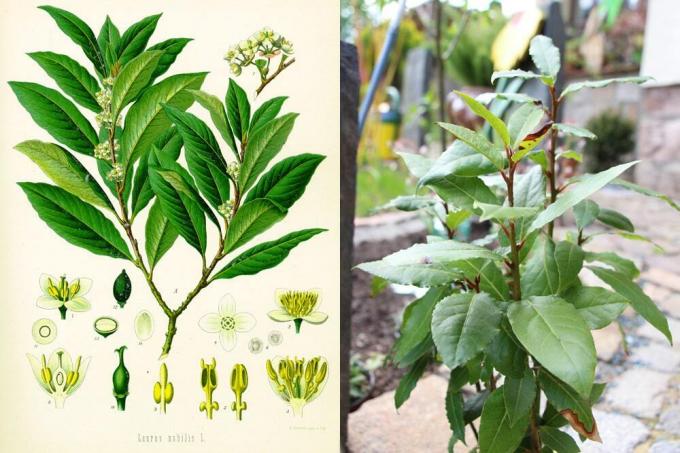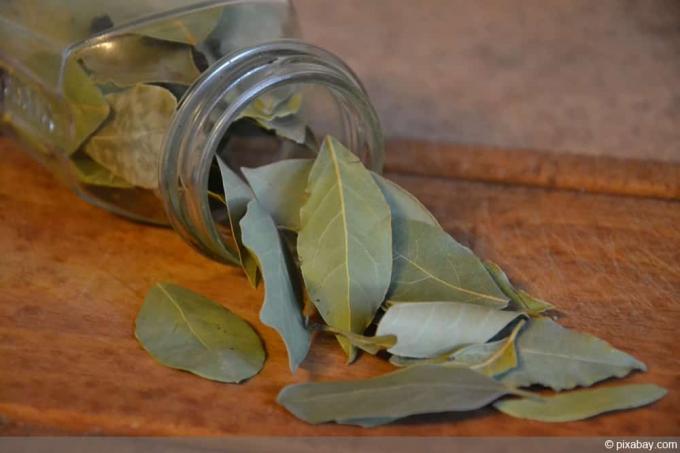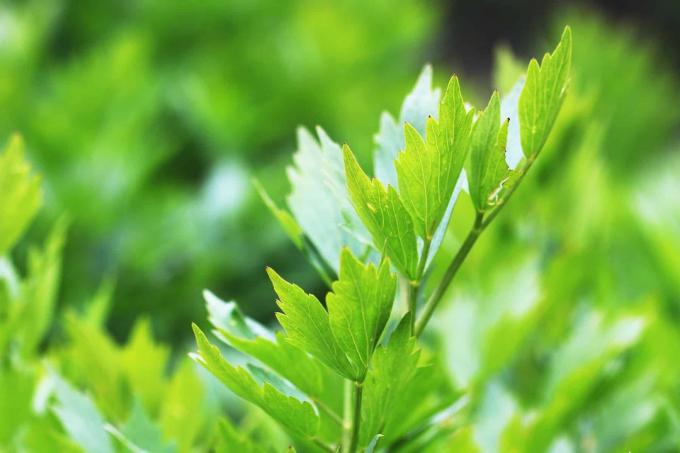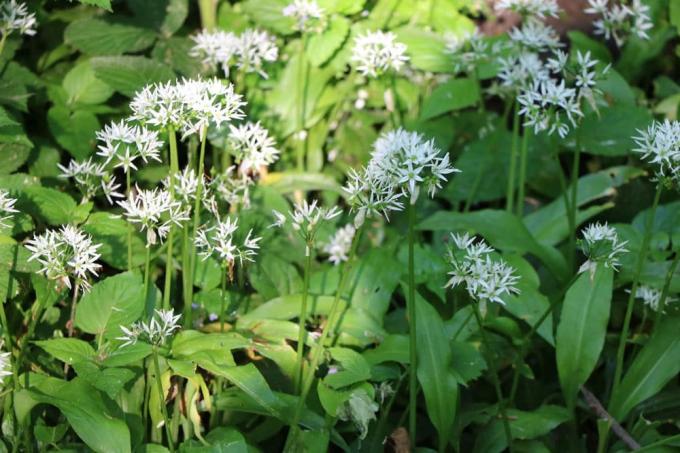

Table of contents
- harvest
- Air drying
- hanging
- baking tray
- Drying using devices
- Freeze
The spicy bay leaves can be picked all year round, but there is not always a need for this. However, the leaves can be preserved by various methods so that they can be used months and sometimes even years later. Which type of preservation is most suitable depends on various factors. Because both individual leaves and whole branches can be dried or frozen.
harvest
The bay leaves are usually picked from plants that are in their second year. This ensures that it develops sufficiently and that the leaves have their full aroma. Single bay leaves can be picked all year round, while larger quantities are ideally harvested in spring or autumn. The harvest is relatively simple, but the following should be observed:
- pluck off the largest leaves
- these have the most flavor
- cut branches
- complete shoot tip including the leaves
Tip:
When harvesting whole branches, around 30 leaves can be harvested at once.
Air drying
Drying the bay leaves has several advantages: On the one hand, the shelf life of the leaves is extended enormously, because the preserved herbs retain their aroma for up to two years. On the other hand, drying reduces the bitter substances, because fresh bay leaves are significantly more bitter. This in turn results in another positive aspect, because seasoning with dried bay leaves is usually easier. Because the fresh leaves season much more, which means that the dishes are often over-seasoned. If you want to dry the freshly harvested bay leaves, you have two methods to choose from. However, both variants have the following things in common:
- gentlest way to dry
- do not wash the leaves before drying
- washing may affect the quality
- Shake leaves to remove dust
- Temperature not above 35 degrees
- Otherwise the aroma will be impaired
Tip:
If the bay leaves are nevertheless washed before drying, they should always be dabbed off with kitchen paper.
hanging

With this method, the entire branches are simply hung upside down in a dry place. The picked leaves can also be dried in this way, but this requires additional handling. Because the bay leaves must first be "threaded" with a needle and thread before they can be hung up. For both methods, however, the following must be observed during drying:
- Location as warm, sheltered from the wind and dry as possible
- Attics, garden houses or drying rooms are ideal
- no direct sunlight
- Hang leaves/twigs loosely and next to each other
- Shake bay leaves regularly
- separate stuck sheets
- this prevents mold formation
Tip:
It is easy to tell whether the bay leaves are dry: if the leaves still have dark green and/or soft spots, they usually still contain moisture. In such cases, it is advisable to let the leaves dry for another week.
baking tray
The bay leaves can also be dried on a baking sheet without much effort. For this purpose, the leaves are first distributed on the baking tray with sufficient distance from each other. To ensure that the laurel dries evenly, it is important that the leaves are placed next to each other and not on top of each other. The baking sheet is then placed in a warm, airy location. The leaves need about two weeks to dry, during which time the following work steps are advisable:
- Check leaves regularly
- Turn over the bay leaves in between
- this way they dry evenly
Tip:
The curling of the leaves can be prevented by covering them with a cloth. The cloth must then be weighed down, for which a board is suitable, for example.
Drying using devices

There is not always enough space to air dry the bay leaves. Fortunately, this is not a requirement, because the spice leaves can also be dried with the help of technical devices. In addition, the drying time is significantly reduced with these variants. Because the leaves only need a few hours to dry instead of several weeks. Although the time savings speak for these variants, there is still a disadvantage: In contrast to the Drying in the air does not protect the aromas so much, which is why there is a slight loss of aroma count is.
dehumidifier
- Preheat device to 35-46 degrees
- Wash leaves with clear water
- pour off excess water
- Blot leaves with a paper towel
- Distribute sheets to inserts
- deploy stakes
- let it dry for about 4 hours
oven
- select the lowest temperature level
- optimal temperature range 30-50 degrees
- Line the baking sheet with parchment paper
- Scatter bay leaves on top
- ensure sufficient space and distance
- Do not close the oven completely
- check again and again in between
- let it dry for about 2-3 hours
microwave
- suitable for few sheets
- Spread leaves on a plate
- Cover the plate with some kitchen paper
- Set the wattage as low as possible
- no more than 300 watts
- otherwise the leaves lose their aroma
- let it dry for about 2-3 minutes
- dry the leaves with kitchen paper if necessary
Tip:
The dried bay leaves can then be crushed and conveniently stored in spice jars or tin cans.
Freeze

Another way to preserve bay leaves is to freeze them. The advantage of this variant is that the aromatic substances of the frozen bay leaves are preserved particularly well. If you want to preserve the spice laurel in this way, you can freeze both the whole branches and individual leaves. With this method, however, the leaves must first be washed before freezing. Then they are freed from excess water and dabbed with a paper towel. The rest of the process differs only slightly, depending on whether branches or leaves are frozen:
Freeze Branches
- Spread sprigs on the baking sheet
- Place the tray in the freezer for 45 minutes
- Remove branches and transfer to freezer bags
- freeze again
freeze leaves
- Pick leaves and chop if necessary
- Lay out the bay leaves on the baking sheet
- Place the tray in the freezer for about 30 minutes
- Remove leaves and transfer to freezer bags
- freeze again
ice cube method
If you don't just want to freeze the bay leaf, but want to portion it out practically in the same step, you can preserve it in ice cube trays. All you need for this is the fresh bay leaves and an ice cube tray anyway. This preservation method requires a little more effort, but this is only a one-off:
- chop fresh leaves
- Pour herbs into ice cube trays
- Fill up the container with water
- Herbs should be covered
- optimal is 2/3 herbs to 1/3 water
- then freeze ice cube trays
Tip:
The herb ice cubes can be used whole for seasoning and do not have to be thawed beforehand!
 garden editorial
garden editorial I write about everything that interests me in my garden.
Learn more about using kitchen herbs

Harvest, dry & freeze lovage: this is how it's done
Lovage (Levisticum officinale) is a popular culinary herb. Unfortunately, freshly harvested, it does not keep for long. However, there are methods to significantly increase the shelf life for longer storage. The right time for harvesting is also important for this.

Harvesting wild garlic while it is in bloom: can you eat it when it is in bloom?
The rumor has spread widely in popular belief that wild garlic is no longer edible from the beginning of the flowering period. This claim isn't entirely true, but there are reasons to pre-bud harvest.

Sow, plant and harvest parsley correctly
Parsley is bitchy? Yes indeed! In the article you will learn how to get the bitch tamed - which is definitely worth it, only very fresh parsley is the real taste and vitamin booster.

14 kitchen herbs that you can really keep in the kitchen
Sometimes a herb garden is only possible on the windowsill. If you don't have your own garden bed, for example, or in the months when the frost freezes the coveted greenery outside. Our list provides an overview of which herbs like the kitchen location permanently.

Insect species: which insects are there in Germany?
In Germany there are around 30,000 species of insects in various shapes and colours. Of these, there are some that are better known than others. In this article you will find a large list of native insects that shape the image of the country.

Drying fresh herbs: make your own spices
Herbs bring freshness and flavor to the table. They are used in cooking and medicine, both fresh and dried. Cultivation is uncomplicated and possible even in the smallest of spaces.



